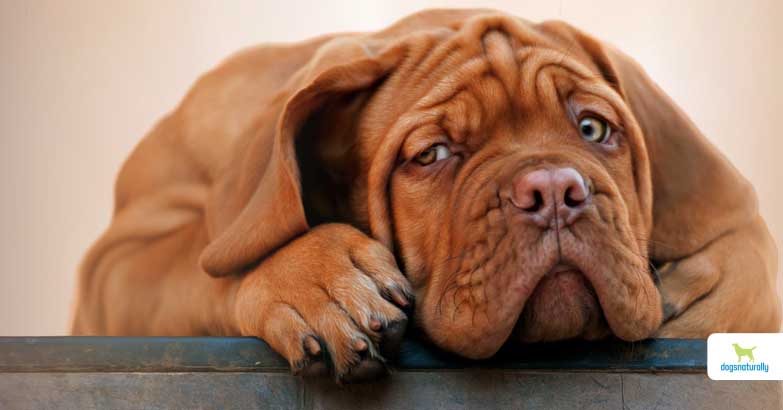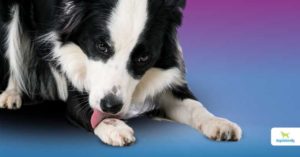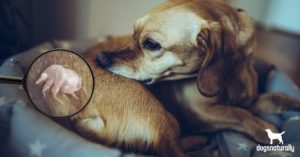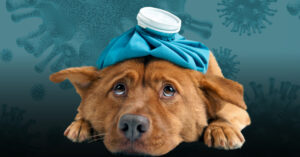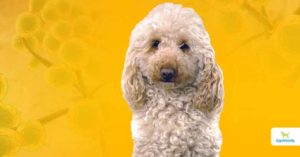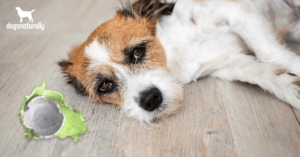Have you ever heard that feeding from a raised bowl is a way of preventing bloat in dogs? Or adding water to your dog’s kibble?
These are common recommendations to avoid bloat. But it turns out these things can actually increase your dog’s risk of getting bloat.
So here are the hard facts from research that’s been done about bloat.
Bloat is a serious, sometimes fatal condition. So, you need to know how to prevent it. But it’s also important to know how to handle this life-threatening emergency in case it happens to your dog.
What Is Bloat In Dogs?
Bloat’s clinical name is gastric dilatation and volvulus (GDV). Volvulus comes from the Latin word volvere, meaning to twist. So that gives you a bit of a clue about what happens.
GDV or bloat is when your dog’s stomach fills with gas and twists. It can twist anywhere from 180 to a full 360 degrees.
When the stomach twists, both ends of it close off, blocking both entry and exit. So then there’s no way for the air built up in your dog’s belly to get out. Not only that, if the air can’t get out, neither can the fluids, foods or gases.
Because there’s no way for the stuff in your dog’s stomach to escape, his belly will start to bloat. As gases build up more, they put pressure on his diaphragm and make it hard for him to breathe.
The pressure also cuts off return blood flow to the heart. At this point, shock sets in.
All of this can happen in as little as 20 minutes. Which is why it’s so important to act fast. Because GDV is deadly if you don’t.
First, which breeds are more likely to bloat?
Breeds Prone To Bloat
Large or giant breed, deep-chested dogs are at higher risk of GDV.
- Great Danes
- Doberman Pinschers
- Standard Poodles
- Old English Sheepdogs
- Irish Setters
- Irish Wolfhounds
- Akitas
- German Shepherds
- Golden Retrievers
- Weimaraners
- Saint Bernards
- Boxers
- Basset Hounds
But don’t get a false sense of security if your breed isn’t on the list. Bloat can happen to any breed or size of dog.
If you have a large or giant breed dog, you’ll want to be extra aware of the signs of bloat.There’s also higher risk of GDV if your dog has a first-degree relative with history of GDV. So ask your breeder about your dog’s family history.
Symptoms Of Bloat
Bloat can come on very fast, so be aware of some symptoms you could see suddenly …
- Agitation – panting, whining or pacing
- Head hanging, stiff movement
- Shaking or shivering
- Burping, drooling
- Trying (unsuccessfully) to vomit
- Bloated abdomen
- Signs of abdominal discomfort or pain
- Shock
- Collapse/loss of consciousness
Bloat often happens right after your dog eats.
You can see some useful videos on YouTube to help you recognize bloat. Here’s one example.
What To Do If Your Dog Bloats
Bloat or GDV is a true emergency. It can happen very suddenly. One dog was fine when the dog walker took him out at 1 pm. By the time the owner got home at 6, her dog was dead. Bloat was the cause.
Clinical signs that last more than 6 hours before treatment increase the risk of death from GDV. So don’t hesitate if you suspect bloat. You must get your dog to the vet right away.
Call your vet on the way if you’re not sure. But do it from the car. You can always turn around if the vet says it’s not bloat. But in case it is, you need your dog to be at the vet clinic.
And while you’re headed to the vet, there are some homeopathic remedies you can give your dog. They might save his life.
Homeopathy Can Help
Even with these remedies, don’t delay in getting to the vet. But try giving your dog one of these remedies on your way. Give the remedy every 15 minutes if you can.
PRO TIP. If possible, bring someone else in the car with you to help out. That way you’re not trying to drive and dose!
These remedies can help relieve the bloat. So when you get to the vet your dog may not need emergency care. But if he does, then you’re in the right place.
Even if you’re not into homeopathy … these remedies are really good ones to have at home …just in case. And if you work with a homeopathic vet, don’t hesitate to call for emergency help selecting a remedy.
Homeopathic Remedies For Bloat
The two best known remedies for bloat are Carbo vegetabilis and Nux vomica. So be sure to have at least these two on hand. Choose a 30C or 200C potency.
Carbo vegetabilis. This is the most common remedy for bloat. Give it if there’s a lot of gas. You’ll see a bloated abdomen, and your dog may be weak. There may be cramping, flatulence and burping. One classic symptom is cold breath or a cold muzzle. The gums or inside the ears may be blue. Your dog may feel better with cool air. And he may feel better if you fan him – he needs air! The bloat may be caused by rich or decayed food … or too much starchy food (think kibble).
Nux vomica. Your dog will have a great deal of cramping. He may be trying to vomit repeatedly. You’ll see hacking and attempts to vomit but nothing comes up. Your dog may be chilly with cold paws. He could be irritable. He’ll feel better with warm drinks. You may see him stretching a lot.
These are two remedies to keep at home. They’re the most commonly used remedies for bloat.
Giving The Remedy
To give them to your dog, tip a few pellets of your remedy into his cheek on the way to the vet. You can give a dose every 15 minutes if there’s time.
Wet Dosing
Sometimes it’s easier to get liquid into your dog instead of the pellets. To make up a wet dose, place a few pellets in a dark glass dropper bottle. Add spring or filtered water. Shake the bottle or pound on the palm of your hand 10 times before each dose.
PRO TIP
If you’re really well prepared, you’ll have these remedies ready to go in their glass bottles. If you make them in advance, replace about 10% of the water with brandy or vodka to preserve the remedies
Changing Remedies
If you have a long car ride to the vet, your dog’s symptoms may change on the way. If you have more than one remedy, be ready to switch to the one that best fits your dog’s symptoms.
Where To Buy Remedies
You can buy these remedies at most health stores. Try Vitamin Shoppe, Whole Foods, or online at smallflower.com, a2zhomeopathy.com or even Amazon.
What Happens At The Vet
If your homeopathic remedy worked, your vet may examine your dog and tell you he’s fine. But if he’s still having a GDV attack, here’s what will happen at the clinic. These are the vet’s priorities …
- Restore blood circulation – via catheter in your dog’s cranial veins
- Decompress the stomach – done with a gastric tube inserted through the mouth or nose. Your dog may be sedated for this.
- Find out if it’s simple dilatation or GDV – via x-rays
- Anesthesia then surgery to correct volvulus (twisting)
- Vets will often recommend a preventive gastropexy (more about this later)
About Surgery
Most dogs with GDV will need emergency surgery. The surgery has two objectives:
- to assess the damage done to the stomach, spleen, and other organs
- to untwist the stomach so gases and bloods/fluids can get out
And many vets will suggest doing additional preventive surgery called gastropexy while your dog is under anesthesia. There’s more information about gastropexy below.
GDV is dangerous … and the treatment can be too. These are some possible complications:
- Low blood pressure
- Heart arrythmias
- Cellulitis or peritonitis from leakage of stomach contents around the gastric tube
- Aspiration pneumonia from preoperative vomiting or postoperative regurgitation
- Gastric necrosis and perforation (up to 5 days after surgery)
- Ongoing low blood pressure, even with fluid therapy, due to loss of electrolytes
- Fluid in the lungs (pulmonary edema) or lung injury as a result of other treatments or heart dysfunction
- Systemic inflammatory response triggered by other factors
- Low blood circulation
The last 3 complications are very serious and reduce your dog’s chances of survival. Your dog may need supplemental oxygen or even a ventilator if these happen.
So … bloat itself is very dangerous for your dog … and it’s risky and expensive to treat, as well.
Should You Allow Preventive Gastropexy?
Your vet may want to do preventive surgery called gastropexy at the same time. Gastropexy involves sewing your dog’s stomach to his abdominal wall. Some vets even recommend gastropexy in young deep-chested breeds who’ve never had bloat. They often suggest doing it at the same time as spay/neuter.
To quote homeopathic veterinarian Dr Dee Blanco on this:
If the vet suggests gastropexy surgery to tack down the stomach to the abdominal wall – STOP right there! The surgery is not without serious consequences.
One very important point is that gastropexy doesn’t stop your dog from bloating. It will only stop the twisting of the stomach. And even that doesn’t always work …
There’s a study about a Rottweiler who’d bloated. He had the emergency gastric resection plus gastropexy. And 4 months later, he got GDV again, His stomach twisted 180 degrees, even after the surgery! (So they performed more gastropexies).
Most vets will tell you gastropexy is safe, but in one study of 49 dogs who had gastropexy …
- 10% had complications from the surgery
- 2 dogs had major postop complications needing additional intervention
- 30% of dogs had minor postoperative wound-related complications
So think very carefully before agreeing to gastropexy … whether your dog’s already had bloat or not.
But it’s obviously best to avoid bloat in the first place. To do that, you need to know some of the possible causes.
What Causes Bloat?
Experts think some possible triggers may be …
- Poor diet
- Swallowing too much air
- Overeating
- Excessive drinking
Diet is a huge factor.
Poor Diet
If you feed kibble, it may cause bloat. A lack of whole, fresh, raw foods in your dog’s diet can have all kinds of consequences. And bloat could be one of them.
High starch diets (kibble) are especially blamed for bloat. Soy and cereal ingredients … plus lower animal protein in the first 4 ingredients can worsen the tendency to bloat.
Surprisingly, one Purdue University study found that cereal ingredients were less of a factor than fats.
Dogs who ate dry foods with fats among the first four ingredients had a 170% increase in GDV.
Making Kibble Safer
Even if you have to feed kibble, you can reduce your dog’s risk. One study showed … adding table food or canned food to kibble diets significantly reduced bloat risk …
- by 59% for large breed dogs
- by 28% for giant breed dogs
Other Factors In Bloat Risk
Genetics can play a role in the risk of GDV.
- It’s more common in larger dogs, especially deep-chested breeds like the Great Dane.
- Dogs with family history of the condition are at higher risk, especially a first-degree relative.
- Male dogs are more likely to bloat.
- Age increases the risk. First episodes of GDV are usually around 10-12 years.
Here are some other risk factors (divided by large vs giant breeds).
Large Breed Increased Risk
In large breeds (but not giant dogs), GDV risk was higher with…
- Raised food bowl
- Fast eating
- Restricting water before and after eating
- Moistening dry food
- Living in a rural area
- Aggression to people
Strangely, in large breeds, attending dog shows lowered the risk of GDV. A submissive nature to dogs or people also reduced the risk.
Giant Breed Increased Risk
In giant but not large breed dogs, these factors made GDV risk worse
- Raised food bowl
- Living in the city
- Lean or thin body
- History of chronic medical problems
- Distended belly after meals
Reduced GDV risk was seen in giant breeds with …
- High level of happiness
- High level of activity
- Fast eating
Stress
For all dogs, stress can be a problem. Stressful events in the 8 hours before a GDV occurrence included …
- Boarding
- Pet sitter or strangers in the house
- Excessive exercise
- Vet visits
- Traveling
- Moving to a new house
PRO TIP
Medications to reduce gas did NOT reduce bloat incidence.
There’s another rather unusual link. Researchers found the odds of bloat are 5.3 times higher in dogs who’ve had their spleen removed (splenectomy).
Preventing Bloat In Dogs
Bloat’s very dangerous … so how can you prevent it?
1. Feed A Fresh Diet
Feed your dog a fresh, whole food, raw meat-based diet.
Your dog’s digestive tract is ideally suited for meat, not grains and starches. Processed foods (kibble) contain a ton of starchy carbohydrates. Your dog doesn’t need them. They can harm his digestive system … and they can increase the likelihood of bloat.
Studies show some dry food choices are especially bad.
- Kibble that has fat in the first 4 ingredients increases your dog’s risk by 170%. (This is likely because fat slows stomach emptying.)
- Kibble that contains citric acid increases bloat risk by 320% if you moisten it before feeding.
A raw diet is best overall for your dog’s health … including for preventing bloat. If you can’t feed raw, choose a less processed, lower starch option like …
- Freeze dried raw
- Dehydrated or air dried
- Canned food
- Home cooked diet
To prevent bloat … just about any diet is better than kibble!
RELATED: Raw Feeding Primer: 10 Simple Rules To Get Started.
2. Give Your Dog Bones
If you feed a raw diet, you probably already know that raw bones are an important part of that diet. These provide important nutrients and can be great for cleaning your dog’s teeth.
What you may not know is that just the act of chewing raw bones is good for preventing bloat.
The right bones will help strengthen the muscles in the stomach. This can improve digestion. So it helps your dog avoid the build-up of gasses in his stomach.
So feed your dog raw meaty bones as part of his diet. And give him some recreational bones to chew on too. Chewing can even be a great stress reliever for your dog.
3. Get Rid Of Raised Bowls
Did you notice in the risk factors above the mention of raised bowls? It may have surprised you. Vets used to recommend these for larger breeds … ironically, to help prevent bloat.
But now, research shows raised bowls increase your dog’s risk of bloat.
Research shows that in 20% of cases in large breed dogs, and 52% of giant breed cases …
… bloat was directly related to having a raised food bowl.
It makes sense too. In the wild, dogs eat off the ground. Nobody’s propping their meal up on a log for them! So having his food at ground level is a much more natural posture for your dog!
4. Exercise – And Timing
Your dog needs exercise. The type and amount differs depending on your dog. But most dogs need at least daily activity for both mental and physical wellbeing. But when you exercise is important too!
Remember all those times your parents told you not to swim right after you ate? Apply that same thinking to when your dog’s exercise.
To prevent bloat in dogs, it is safest not to exercise your dog right after he eats. When his stomach is full, it’s more likely to flip and twist. This includes vigorous game playing too – so no wrestling or tug of war right after dinner
5. Avoid Stress
Be aware of situations that cause your dog stress … and try to minimize them. Give your dog ample play … or get him out on stress-relieving walks in nature to help him relax, Also, remember your dog is very tuned in to you! So managing your own stress can help him too.
A Note For Breeders
Please don’t knowingly breed a first-degree relative of a dog who’s had GDV. Research shows this could reduce the incidence of GDV by 60%.
Sometimes even the ER can’t save your dog from bloat. 25% to 30% of dogs still die from GDV. So, preventing it is vital. Luckily, there are several ways to lower your dog’s risk. And you’ll improve his overall health at the same time.
Angela J Sartor et al. Association between previous splenectomy and gastric dilatation-volvulus in dogs: 453 cases (2004–2009) Journal of The American Veterinary Medical Association, May 15, 2013, Vol. 242, No. 10, Pages 1381-1384.
Glickman LT, et al. Multiple risk factors for the gastric dilatation-volvulus syndrome in dogs: a practitioner/owner case-control study. J Am Anim Hosp Assoc 1997;33:197–204.
Glickman LT et al, The Effects Of Ingredients In Dry Dog Food on the Risk of Gastric Dilatation-Volvulus in Dogs. J Am Anim Hosp Assoc. January-February 2006, Vol, 42.
Glickman LT et al. Non-dietary risk factors for gastric dilatation-volvulus in large and giant breed dogs. J Am Anim Hosp Assoc 2000 217:10, 1492-1499.
Loy Son NK, et al. Long-Term Outcome and Complications Following Prophylactic Laparoscopic-Assisted Gastropexy in Dogs. Vet Surg. 2016 Nov;45(S1):O77-O83. doi: 10.1111/vsu.12568. Epub 2016 Oct 5. PMID: 27706826.
Hammel SP, Novo RE. Recurrence of gastric dilatation-volvulus after incisional gastropexy in a rottweiler. J Am Anim Hosp Assoc. 2006 Mar-Apr;42(2):147-50.
Daniel J. Brockman, BVSc, CVR, CSAO, DACVS, DECVS, FHEA, MRCVS. GDV Treatment: A Recipe for Success. World Small Animal Veterinary Association World Congress Proceedings, 2013.

